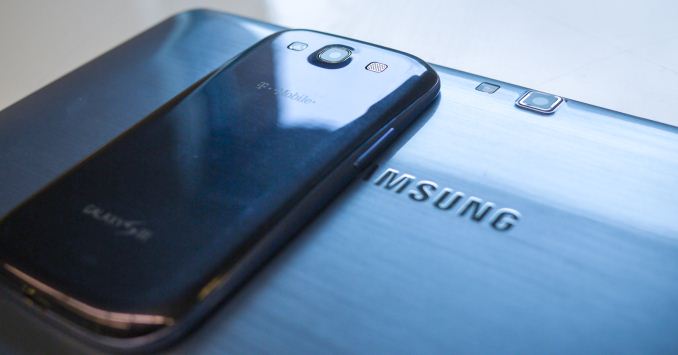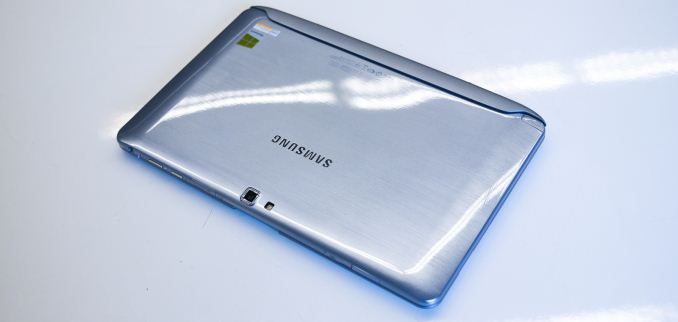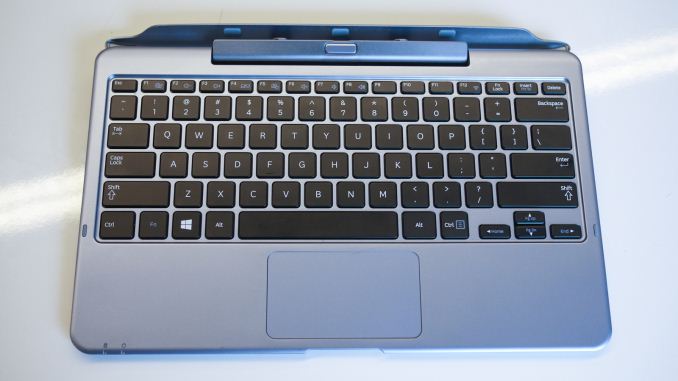Samsung ATIV Smart PC: Revisiting Clover Trail Convertibles
by Vivek Gowri on March 18, 2013 12:00 AM ESTSamsung ATIV Smart PC: Design
The ATIV Smart PC is unmistakably a Samsung design, for better or for worse. The front face is dominated by the display, along with details like the chrome-ringed Windows button, speakers placed on the right and left edges in similar fashion to the Galaxy Tab and Nexus 10, and the webcam and Samsung logo centered above the display. The bezel is uniformly three-quarters of an inch thick all the way around the screen, which allows for comfortable handling of the device without adding too much bulk to the footprint. The body is entirely glossy plastic, with contours similar to the rest of Samsung’s recent mobile industrial design language. The brushed plastic aesthetic in particular will be very familiar to anyone who has handled a pebble blue Galaxy S III or Galaxy Note II in recent times. This isn’t as dark a blue, but they’re clearly related products.
The ATIV Smart PC is kind of chunky though, with a width of 12” and a weight of 1.65lbs. It’s not that thin, either, though it does feel thicker than 9.9mm. It’s too big for ideal one handed use, and the dimensions of 10.1” slates (10.5” wide, roughly 1.25lbs) tend to be much better suited for that ergonomically. The problem though, with this slate in particular, is that it feels both bulky and not that well built. The plastic body offers pretty poor in hand feel, with a disconcerting amount of flex exhibited in normal day-to-day handling.
Samsung’s build quality on their plastic products has never thrilled me, particularly the original Galaxy S and Galaxy S III. They clearly know how to design a good looking computer, with their Series 7 and Series 9 notebooks and all-in-ones featuring attractive and well built aluminum bodies. The ATIV doesn’t even cut it from a plastic standpoint, with noticeable seams between the various injection molded plastic pieces that comprise the chassis. Next to the VivoTab, the Samsung feels bloated—the aluminum body of the ASUS is far higher quality and the thinner chassis is much better ergonomically. And compared to tablet design benchmarks like Surface and the iPad, it’s not even on the same planet.
Button and port placement is a bit haphazard, with microHDMI and volume controls on the right side, a USB port, 3.5mm combo jack, microSD card, and microSIM slot located on the top of the device, along with two chrome buttons (power and rotation lock) that are easy to confuse. One, the idea of a SIM slot on a device that doesn’t have a cellular radio is downright baffling. Two, all the ports have flaps. Three ports, a dummy SIM slot, and four flaps. It’s unclean, fiddly, and an industrial design faux pas in this day and age. I’m not necessarily the biggest fan of the top-mounted USB port, but at least it’s better than the ASUS VivoTab’s easy-to-lose and hard-to-replace dongle. Other miscellaneous design details: the raised chrome detailing around the webcam is very Galaxy S III-esque, the Wacom stylus on the side can be difficult to remove from the silo at times, and the Windows and Intel logo stickers on the back are the height of uncool.
The keyboard dock is a definite bright spot. When you add it to the slate, the total size goes up to 3.1 pounds and 0.85” thick. It’s made of a matte plastic that feels better and more solid than the tablet, with a spacious and comfortable chiclet-style keyboard along with a buttonless ELAN multitouch trackpad. The dock also has two USB ports, one on either side, and both are covered by flaps (tragic).
The tablet connects to the dock with two clips and a 13 pin trapezoidal connector, and disengages with a button located at the center of the hinge. It’s a bit buggy at times—something about the electrical connection between dock and tablet occasionally goes on the fritz, resulting in a series of disconnections and reconnections usually fixed by adjusting the hinge angle or removing and reinserting the tablet. Unlike ASUS keyboard docks, the Samsung docks don’t include a battery. This results in a thinner, lighter dock, but having a second battery in the dock would probably be worth the extra bulk, for reasons I’ll discuss in the battery life section.
The ATIV Smart PC design and hardware is adequate, but honestly, based on the Windows tablets I’ve been dealing with in the last six months, I’d put Samsung behind Microsoft, ASUS, Vizio, and even Acer when it comes to Windows 8 tablet hardware design. Compared to the level of industrial design and quality we’ve come to expect from the current crop of tablets and ultrabooks, Samsung has really missed an opportunity to even be competitive here.














59 Comments
View All Comments
jtsmall - Monday, March 18, 2013 - link
Then look at the HP Envy X2 here http://bit.ly/114Mcnb and here http://zd.net/114NqPgThis dockable Win 8 Atom Z2760 tablet sounds like what you're asking for.
DanNeely - Monday, March 18, 2013 - link
The Envy's currently at the top of my candidate list due to price; but it's a big bigger than I really want. I can stuff a 6.5" laptop into the pockets of holding in a few of my pairs of pants which, while a bit awkward, is less of a hassle than either carrying it loose or wearing a backpack for a single item. The 7.5" tall form factor of the Envy (and every other atom tablet/laptop combo) is too big to fit.nerd1 - Monday, March 18, 2013 - link
Envy x2 is almost perfect EXCEPT FOR the (current) lack of active digitizer solution. They said they will have some digitizer (Atmel?) but no one has confirmed that it actually works yet.DanNeely - Monday, March 18, 2013 - link
What's the current status of Clovertrail drivers? A number of initial reviews mentioned them still being a bit flaky; if those problems have been sorted out is something I was really hoping to see on a review dated a few months after launch.powerarmour - Monday, March 18, 2013 - link
Intel doesn't want anyone to talk about them, it's their massive Achilles heel on their PowerVR based chipsets, they are absolutely dreadful for anything 3D related, even 2D is pretty badly borked... :PDeath666Angel - Monday, March 18, 2013 - link
Thanks for the review!I have the XE700T1C and am looking forward to your review of it. I had to decide between spending 850€ for good battery life but mediocre performance (even lower than the i3-330UM Acer laptop it should replace) or spending 1300€ for something that has enough battery life and all the performance I can expect and need in a portable machine. :D I expect that Temash/Kabini will offer more of a balance, but those are vapoware as of now. :(
I agree that the dock could use a battery, really a shame they didn't include it. However, I do like the flaps on the ports. Gives it a cleaner look than having the stuff open. What would be your alternative to the flaps? :) I wouldn't mind them being slider mechanisms. But I take the flaps over open ports any day.
On my XE700T1C, I had no trouble peeling off the stickers, so I don't think that is a big point. There is also nothing of importance printed onto it.
You could do more to elaborate on the typing experience with the dock and the stylus experience.
Death666Angel - Monday, March 18, 2013 - link
Forgot something. You say 10.1" is the nicer form factor. I disagree. 10.1" is fine if all you do is run Metro apps or desktop apps in full screen. But running 2 programs side by side is really terrible for me with 10.1" screens. The 11.6" screen of my XE700T1C has the perfect size to start running 2 apps side by side. The larger size also makes taking notes easier for me. I don't think one size fits everyone, so I'm not trying to tell everyone to use 11.6". But there are legitimate reasons to go to the bigger screen. The size difference is easily offset by the pros for me.And if people don't need the Wacom digitizer, they should think about the W700 from Acer. It is super cheap and has the best battery of any Core tablet. It doesn't offer a keyboard dock though (only a stand and a bluetooth keyboard). But the performance is ridiculous when compared to Atom powered stuff and it still usually offers 7+ hours of battery life. If people want a try with the higher performing Windows tablets they should look for the Samsung predecessor of the XE700T1C, the XE700T1A (Series 7 Slate) which comes in Celeron and Core i5 2nd gen flavors and a lower resolution screen without the keyboard dock but with a desktop dock and a bluetooth keyboard with an active digitizer. :) It costs as much as most Atom powered tablets with a few extras here cost.
powerarmour - Monday, March 18, 2013 - link
Shame about the absolutely dire Clover Trail graphics drivers though...beginner99 - Monday, March 18, 2013 - link
The Mozilla Kraken Benchmark must contain an error. The Razr i beats clovertrail by a huge margin while obviously being much slower (medfield). Something is not right in that benchmark.A.J. - Tuesday, March 19, 2013 - link
That's because Razr i using Chrome-like browser in Android.You can easily get ~12000ms in Kraken using Chrome25 in the z2760 platform.